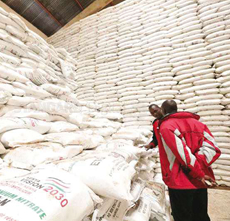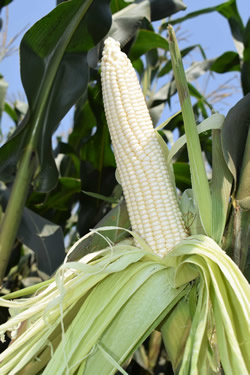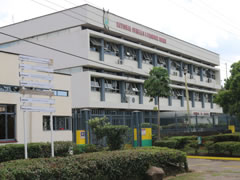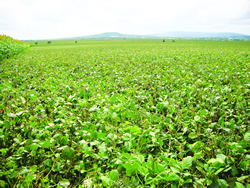Restructuring of The National Food Reserve and Food Storage Management
 Up until 1980 Kenya produced sufficient basic food to feed its population and reaching a surplus of 20% by the mid-1970s. Since then agricultural production has fluctuated year-on-year. At the same time, Kenya has seen sustained high growth in population, nearly a six-times increase since 1963. This compares with 2.2 growth index of staple cereals from 1963 to 2017. The food deficit of maize, rice, irish potatoes, wheat and sugar continues to widen. By 2017, Kenya’s basic food production could regularly feed 72% of the population.
Up until 1980 Kenya produced sufficient basic food to feed its population and reaching a surplus of 20% by the mid-1970s. Since then agricultural production has fluctuated year-on-year. At the same time, Kenya has seen sustained high growth in population, nearly a six-times increase since 1963. This compares with 2.2 growth index of staple cereals from 1963 to 2017. The food deficit of maize, rice, irish potatoes, wheat and sugar continues to widen. By 2017, Kenya’s basic food production could regularly feed 72% of the population.
In pursuit of 100 % food and nutrition security, the Ministry of Agriculture, Livestock, Fisheries and Cooperatives (MoALF&C) developed the Agriculture Sector Transformation and Growth Strategy (ASTGS) 2019-2029. The ASTGS identifies nine flagships critical in addressing systemic bottlenecks constraining Kenya’s ability to achieve food and nutrition security. In particular, Flagship 5 proposes restructuring of the Strategic Food Reserve to better serve Kenyans.
Furthermore, the Pillar on Food and Nutrition Security of the Big 4 Agenda sets the production targets which include increasing maize production from 40 to 67 million (90kg) bags; rice production from 112,800 to 406,486 metric tons; meat production from 700,000 to 990,000 metric tons; processed milk production from 630 million to 1 billion litres and fish production from 135,100 to 231,359 metric tons.
Along with the increased production, the Strategy targets to lower post-harvest losses from 20% to 10% and increase benefits from value chain efficiency by at least 50%. This will be achieved through improved storage, value addition and trade.
Currently, stocks for the Strategic Food Reserve is handled by the National Cereals and Produce Board (NCPB). In the ideal situation, the Strategic Food Reserve Trust Fund (SFRTF) would buy and sell maize stocks with the aim of creating stability in pricing and stock for the benefit of both producers and traders. The NCPB dominates the grain storage with capacity of 1,841,467 tonnes compared to 173,000 and 58,000 tonnes operated by private sector and other government agencies (Kenya National Trading Cooperation - KNTC and Kenya Farmers Association - KFA) respectively.
On the other hand, the Strategic Food Reserve Trust Fund (SFRTF) was established in 2015 to stabilize the food supply and prices, and maintain adequate strategic food reserves in physical stock or cash equivalent. Whereas Kenya’s approved food reserves includes six (6) food commodities - maize, rice, beans, powdered milk, canned beef and fish, yet maize accounts for 95% of NCPB and SFRTF transactions.
Historically, the Government, through the Strategic Food Reserve has intervened in the maize market, purchasing soon after the harvest, at often higher prices than the prevailing market, store with the NCPB and later release to the market when supplies are depleted, mostly at prices below the market price. 
The practice where maize is bought at above market prices and released at lower than market prices undermines the basic functioning of the food market and sustains manipulation by cartels. This situation disadvantages producers, and undercuts both the commercial and strategic food reserve system. The preferential agency arrangements of SFRTF with NCPB, coupled with blanket government subsidies has out-crowded private sector participation in the food warehousing system.
Moreover, the maize sub-sector has dominated attention and resource allocation in the Ministry of Agriculture, influenced by short term interventions. Consequently, this has drawn attention away from broader and more strategic action for improving Food and Nutrition
Security.
This situation is both undesirable and unsustainable.
Four clear options contributing to Food and Nutrition Security.
Physical food, cash or voucher transfers to chronically food insecure households.
Managing stock volatility in case of glut, shortages or panic through purchase and sale of strategic reserve to the market.
Stimulate or orient food production by use of incentives and remunerative returns for farmers, Increase stable food trade by maintaining predictable range of producer and consumer prices, and thereby to avoid panic or speculative trading.
 With regard to assistance to the food insecure persons, and where necessary, the Government sees direct cash transfers as being a more transparent and efficient way to execute support. It provides beneficiaries with the dignity of choice over what to buy and from whom, while enhancing local food trade and value for money by cutting out the middlemen. Otherwise, the identification and delivering assistance to food vulnerable is the realm of the Ministry of Interior and Coordination, Social Protection and the State Department of Devolution, and NOT the Ministry of Agriculture.
With regard to assistance to the food insecure persons, and where necessary, the Government sees direct cash transfers as being a more transparent and efficient way to execute support. It provides beneficiaries with the dignity of choice over what to buy and from whom, while enhancing local food trade and value for money by cutting out the middlemen. Otherwise, the identification and delivering assistance to food vulnerable is the realm of the Ministry of Interior and Coordination, Social Protection and the State Department of Devolution, and NOT the Ministry of Agriculture.
In order to address the perennial challenges facing agricultural production and trade, the Cabinet has directed reforms anchored on among others;
Warehouse Receipt System (WRS) as an open trading platform that links buyers and sellers, and modelled along the stock exchange. Importantly, the Warehouse Receipt System will remove the logistics burden and facilitates producers and traders to access agricultural credit against the deposit certificate. As you may be aware, the Warehouse Receipting Council has now been appointed and we shall soon be inaugurating the Council and appointing an acting CEO.
Enhanced private sector participation in the agricultural value chain, including storage, thereby creating a competitive food market and the efficiency that comes with it Revamped Food Balance Sheet Committee to oversee accounting and monitoring of the country’s food supply pattern, utilisation and distribution.
Institutional reforms to eliminate overlapping roles, conflicts between different government agencies and better respond to changing food demand.
Results
The government will not directly buy, sell maize or set prices of maize The government will no longer purchase, distribute, sell or set prices of fertiliser, seeds or any farm inputs
Going forward the government will focus on its key role, that of creating an enabling environment for producers and traders to make and execute commercial decisions, while ensuring that commercial interests, especially on imports do not disadvantage local producers and consumers.
Establish within NCPB the National Food Reserve (NFR) buttressed on commercial processes, the Warehouse Receipt System and targeted incentives directly to registered farmers designed to avoid market distortions and opaqueness.
Institutionalize within NCPB the Food Balance Sheet Committee with broad representation as a statistical and advisory organ on incentives and strategic food reserve decisions making.
To separate the National Food Reserve functions from the commercial ventures, NCPB will restructure to create the NCPB Trading Division (NTD). NTD will operate unencumbered commercial agricultural hub model, clustering registered small-medium holder farmers and agro-dealers around aggregation centres (cooperatives or warehouses) for storage, bulk inputs sourcing, marketing and extension support. Going forward NTD will compete for opportunities on value and price alongside other market players in Kenya.
Other agencies like Kenya National Trading Corporation, Cooperatives and also the private sector will be encouraged and incentivised to embrace this model, which is key to creating supportive infrastructure for farmers and cutting post-harvest losses.
 Through this process, the government intends to stimulate growth of 750 farmer facing agro-dealers and equipment suppliers, and 150 storage facilities and processors in 20 agricultural value-chains by 2025 To encourage the early participation of the private sector, and the establishment of ware receipt housing system, NCPB will release 7 million bags of space through competitive commercial leases. The release of designated storage space to private sector will proceed speedily and completed by December 2020 Finally, starting from September this year, the Agriculture and Food Authority in collaboration with the counties will undertake the registration of farmers, dealers, and the licensing of primary warehouses, the Warehouse Receipt Council will be responsible for warehouses trading in the Commodity Exchange (KoMEX).
Through this process, the government intends to stimulate growth of 750 farmer facing agro-dealers and equipment suppliers, and 150 storage facilities and processors in 20 agricultural value-chains by 2025 To encourage the early participation of the private sector, and the establishment of ware receipt housing system, NCPB will release 7 million bags of space through competitive commercial leases. The release of designated storage space to private sector will proceed speedily and completed by December 2020 Finally, starting from September this year, the Agriculture and Food Authority in collaboration with the counties will undertake the registration of farmers, dealers, and the licensing of primary warehouses, the Warehouse Receipt Council will be responsible for warehouses trading in the Commodity Exchange (KoMEX).
To spearhead the implementation of these reforms, the minister appointed a Technical Working Committee charged with coordinating prompt and focused implementation of these reforms, and further to ensure that systems are in place to receive produce by October 2020.
In addition, he will invigorate the NCPB Board and inject the required expertise for oversighting the revamped functions of NCPB. To better ensure that NCPB as an organization execute more effectively and devoid of historical burdens the Technical Committee and NCPB Board will immediately undertake capacity and suitability vetting of all the serving officers.
In the long term will undertake a policy legal review towards the harmonization of mandates of various agencies under the agriculture sector towards enhancing their complementarity.
The Ministry will provide the stakeholders and the public with regular updates on progress.
These measures will be implemented with immediate effect in readiness for the main harvest season in October 2020.